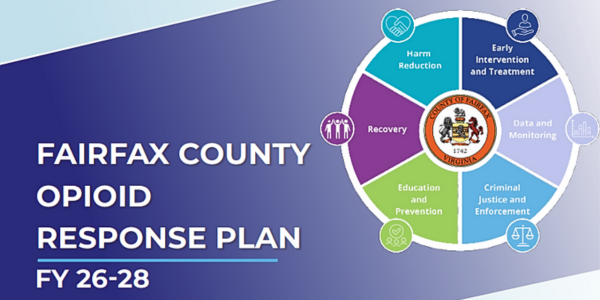
For many years, Fairfax County has worked to address the local impacts of the national opioid epidemic through a multi-pronged strategy involving a wide range of stakeholders. Significant local resources, strong cross-system collaboration and county leadership united in their commitment led to the creation of an Opioid and Substance Use Task Force in 2017 and has resulted in several programs and initiatives that have helped individuals and families dealing with the impacts of substance use disorder.
This work has been outlined in and guided by Fairfax County’s Opioid Response Plan, which was recently updated for FY 26-28 (plans from prior years are available online).
FY 26-28 Response Plan at a Glance
The Fairfax County FY 26-28 Opioid Response Plan includes many programs/activities across six priority areas: Education and Prevention; Early Intervention and Treatment; Data and Monitoring; Criminal Justice and Enforcement; Harm Reduction; and Recovery. Collectively, these programs/activities aim to:
- Reduce deaths from opioids;
- Prevent opioid misuse;
- Improve the quality of life of individuals impacted by opioid use disorder; and
- Use data to describe the problem, target and improve interventions and evaluate effectiveness.
Notable recent milestones include:
- Promoting Fairfax County Public Schools’ “Become Unskippable” communications campaign which provides tips to parents/caregivers on how to speak with youth about opioids and fentanyl;
- Enhancing resource navigation support to families seeking behavioral health services for county youth (including both mental health and substance use services);
- Extending the Fairfax-Falls Church Community Services Board’s Addiction Medicine Clinic office hours for medication for opioid use disorder services for individuals 18 and above; and
- Awarding a contract for regional youth detoxification, substance use residential treatment and crisis stabilization services (services are anticipated to begin in the first half of Calendar Year 2026).
Opioid settlement funds are being used to advance eight programs/activities. While other federal and state grant funds are also used to support several programs/activities, most are locally funded, reflecting the county’s longstanding commitment to address the opioid epidemic’s profound impact on the Fairfax community.
What’s Next
While the national, state and local decline in fatal opioid overdoses from 2023 to 2024 is encouraging, there are still far too many fatal opioid overdoses in the Fairfax Health District and much work to be done to meet the multifaceted needs experienced across the community.
As these programs and activities advance over the next three years, data-informed modifications will be made to enhance effectiveness and adapt to emerging issues/trends (such as the constantly evolving nature of the illicit drug supply). This will ensure that every possible tool and resource available is working towards the goals of reducing opioid deaths, preventing opioid misuse and improving the lives of those impacted by opioid use disorder.



 SIGN UP FOR DAILY EMAIL HEADLINES
SIGN UP FOR DAILY EMAIL HEADLINES